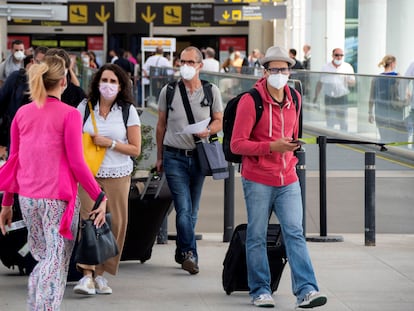Closed hotels and deserted streets: the unrecognizable face of Spain’s tourism industry
Many establishments in Tenerife, Ibiza and Benidorm are shut due to a lack of customers. The British decision to keep the country off its green list list has been a blow to the sector

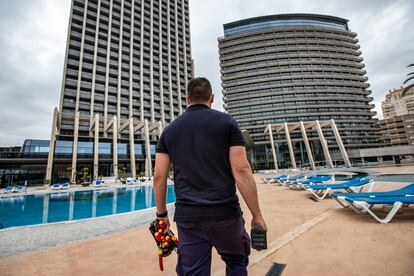
Last week, in the month when the summer season begins, you could walk through one of Spain’s main vacation destinations without bumping into a single tourist. All that was to be heard was the sound of the sea, or workmen fixing the street. That reflects the extent to which the coronavirus pandemic has hit the country’s tourism sector, a key industry that accounted for 12.4% of GDP in 2019 – €154 billion – as well as 2.72 million jobs, which is 12.9% of the total.
Right now, the south of Tenerife looks like a miniature model, like the set for a once-bustling party. The lack of tourists from the United Kingdom, a country that is still imposing a quarantine on travelers returning from Spain, has dealt the island a huge blow. All around the place the signs are in English, but there are no Britons here. That has the knock-on effect of meaning that there are no taxi drivers waiting on the streets, and restaurant chains that usually would have lines outside for tables are not even open. The businesses that are operating are often ending the day without a single sale.
Tourism is a chain, and in the same way as the bursting of the real estate bubble ruined a small village of 10,000 inhabitants – Villacañas, which has produced as many as 11 million doors a year – the pandemic has caused a disaster with a domino effect that is leaving companies big and small on a cliff edge.
On the Balearic Island of Ibiza, which the UK has also left off its “green list” of travel destinations, there is somewhat more movement, but the figures for reservations are still far from those of 2019. Take a walk around Sant Antoni de Portmany and you will see a succession of padlocks and closed doors at hotels and venues on the beachfront. On the Levante coast the story is the same. Toni Mayor, the head of the Hosbec business association, explains that “60% of the hotels in Benidorm remain closed because national tourism is not enough.” He adds: “Let’s say that we are in the middle of a storm, and hanging on to a child’s flotation device.”
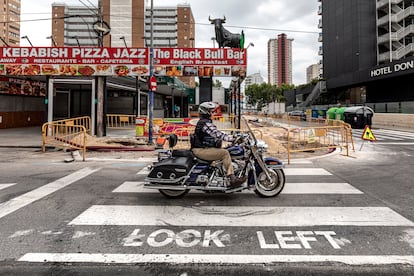
From today, tourist arrivals in Spain will be able to present a negative antigen test, which are quicker and cheaper than PCRs. This is good news for the sector. But the fact that UK tourists can freely come to Spain without a test, but must quarantine on return and take two home PCR tests while doing so, is a disaster.
Fifteen months after the pandemic took hold, and the country’s tourism destinations paint an unrecognizable picture. “The pandemic has particularly affected tourism,” says Gonzalo Fuentes, who represents the sector at the CCOO labor union. “It’s practically a monoculture in places like the Canaries and the Balearics. But unlike in other crises, like [the financial meltdown of] 2008, jobs have been saved this time.” Fuentes points to the government’s ERTE furlough scheme, in contrast to the EREs of 2008 – mass layoffs executed by companies. He attributes this difference to dialogue between the government, labor unions and employer groups.
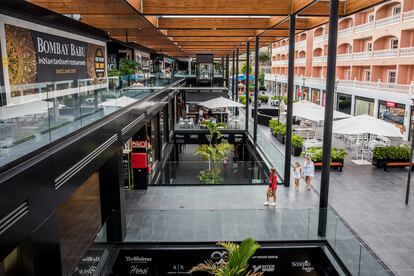
The 20 or so employers and workers consulted for this feature agree that the furloughs have been very useful, but they believe that when the scheme ends there could be mass layoffs once more. Some businesses have fought to stay open, while others have reopened recently after adapting their premises to make them more resistant to the virus.
The Canary Islands currently have a cumulative coronavirus incidence rate of 70 cases per 100,000 inhabitants over the last 14 days. For the Balearic Islands, the figure is 34.19. The average for Spain is 102.
Here are the stories and experiences of people from the sector.
Restaurants. The fall of the “Golden mile”
Lorenzo Reverón has been in the sector for 29 years. He began as a waiter, opened his first restaurant in Tenerife in 1992, and it went so well that he ended up having 84 establishments along with his partners. His group, Gourmetland, now counts on 23, 12 of which are on the so-called “Golden mile” (Avenida de las Américas). “It’s dead,” he complains. “It’s the worst street of all of them.” They have only been able to open six of the 23 restaurants, and they have pulled 80 staff members off furlough to operate them. They also count on a complex of 85 apartments, but the occupation level is just 10%. “Going out onto the street is devastating,” he complains.
Hotels
“I’ve gone through all of the crises,” explains José Enrique Durán, the director of Los Olivos complex in Tenerife. He’s been in the sector for 10 years, and before that was a bank executive for more than two decades. “Until the financial crisis of 2008 arrived, and there was an ERE at Caixa Catalunya and I reinvented myself,” he explains. “The coronavirus has been much worse than that was because this has affected all sectors, all over the world.”
Los Olivos has not, however, closed at any time during the pandemic – not even during last year’s lockdown, when it was attending to “tourists left behind, healthcare workers and emergency crews.”
Seventy percent of his 48 employees are still on furlough. “Without that mechanism, we would have gone bust,” Durán explains. Tita Alexandru, a 29-year-old waiter, is one of the lucky ones who is already working full time. “It’s been a very hard year,” he explains. “I was just getting by and I even thought about going back to Italy after four years in the Canary Islands, but I’ve been working for one month and 10 days full time and I’m very happy.”

Theme parks. The challenge of maintenance
Tenerife’s Siam Park, the best water park in the world according to TripAdvisor, opened its doors last weekend after 14 months closed. They sold 1,500 tickets a day and they were happy – although in July, before the pandemic, they could see 10,000 daily visitors.
Rafael Márquez, the technical director, has been working around the clock to ensure that all of the complex and delicate machinery is well taken care of. During the high season, there are 500 people working in the park. Some of the employees are being taken off their ERTE furlough schemes. “Before we had 10% of national tourists and 90% from abroad, but now that’s been reversed,” he explains. “Some French people are arriving, some Russians… But it’s still a trickle.”
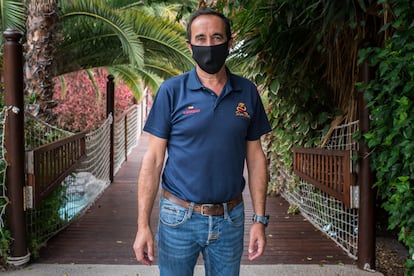
The reopening of the park is encouraging the owners of hotels and hostels, because the park is one of the biggest attractions for families.
Changes in supply and demand in Ibiza
In Ibiza airport there is somewhat more noise and activity. On May 28, the Ushuaïa beach hotel reopened. It belongs to the Palladium group, which counts on 47 hotels in more than six countries, 12 of them on the Balearic Islands. Its marketing director, Iñaky Bau, is optimistic. “The market is getting more lively and there is a trend of reservations for September and October,” he explains. The group has 13,000 employees in total and a large proportion of those from Spain went on furlough. Of the 367 staff at Ushuaïa only 135 are yet to return full time. The current occupation is 37% and the profile of clients has changed. “We’ve gone from an average age of 25 to 40, to 40 and 55 and with higher spending capacity,” explains Charo García-Madrid, the director of accommodation. “Our public was mostly British, but now we have Germans, Dutch, Swiss, Italians…” And that’s all after a year when, as Bau explains, they have had to prepare “for thousands of scenarios, make plans, throw them in the trash and adapt to the series of changes to the coronavirus rules.” Loly Figueroa, the director of the hotel, recalls that they all burst into tears with emotion the day of the first check-in.
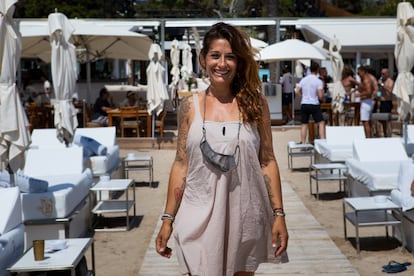
Regina Scardaccione is in charge of reservations at the Blue Marlin, a beach club in Ibiza’s Jondal bay and a destination for the likes of soccer stars Messi or Cristiano Ronaldo. She explains that in 2020 she only worked 57 days. “Normally I live the whole year from the six months of the season, but last summer we opened in July and in September we had to close,” once the UK toughened up its travel restrictions once more. “The €1,300 I got from the ERTE all went on paying rent because here it is so expensive. We reopened on May 21, and saw something of the light at the end of the tunnel. I hope that we can hang on until October.”
During the high season, the club provides work for nearly 350 people, 200 of whom are permanent and are stationed in the restaurant, the beach service, the dance area and the bars. Mattia Olivieri, the general director of the Blue Marlin, explains that the company has had to help out some of the families because their ERTE money was not sufficient. “The British are between 60% and 70% of our clientele. Normally, in January we have 40% of July booked up. A concert day can see 2,000 people pass by here, but know we have a quarter of this.”
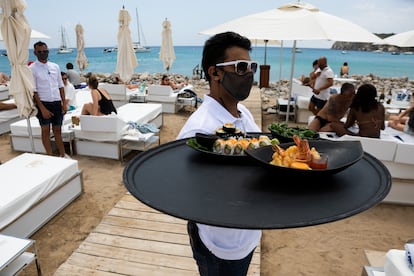
The future: quality or volume
Antoni Riera, a professor of applied economics at Balearics University, provides a piece of data to explain the damage the pandemic has caused. “International tourist spending in 2020 did not even reach the equivalent of 20 days in the summer of 2019.” Asked if he thinks that things will go back to how they were, he says that he sees this standstill as an opportunity to reflect on the model. “Covid-19 may have radically altered the concept of destinations. The density and connectivity, seen as strong points for tourism, could now be seen as weaknesses from now on. In the same way that digitalization spurred by the lockdown and home working will bring permanent changes to the way work is organized, the effects of Covid will continue to affect the tourism sector once the health crisis is over.”
Associations representing businesses and entrepreneurs in Tenerife are preparing projects that will be paid for with European Union funds, such as recovering marine reserves to attract scuba divers, or creating cycling routes and rural restaurants.
All that’s missing now are the tourists.
Tu suscripción se está usando en otro dispositivo
¿Quieres añadir otro usuario a tu suscripción?
Si continúas leyendo en este dispositivo, no se podrá leer en el otro.
FlechaTu suscripción se está usando en otro dispositivo y solo puedes acceder a EL PAÍS desde un dispositivo a la vez.
Si quieres compartir tu cuenta, cambia tu suscripción a la modalidad Premium, así podrás añadir otro usuario. Cada uno accederá con su propia cuenta de email, lo que os permitirá personalizar vuestra experiencia en EL PAÍS.
¿Tienes una suscripción de empresa? Accede aquí para contratar más cuentas.
En el caso de no saber quién está usando tu cuenta, te recomendamos cambiar tu contraseña aquí.
Si decides continuar compartiendo tu cuenta, este mensaje se mostrará en tu dispositivo y en el de la otra persona que está usando tu cuenta de forma indefinida, afectando a tu experiencia de lectura. Puedes consultar aquí los términos y condiciones de la suscripción digital.
More information
Últimas noticias
Most viewed
- Sinaloa Cartel war is taking its toll on Los Chapitos
- Reinhard Genzel, Nobel laureate in physics: ‘One-minute videos will never give you the truth’
- Oona Chaplin: ‘I told James Cameron that I was living in a treehouse and starting a permaculture project with a friend’
- Why the price of coffee has skyrocketed: from Brazilian plantations to specialty coffee houses
- David King, chemist: ‘There are scientists studying how to cool the planet; nobody should stop these experiments from happening’
